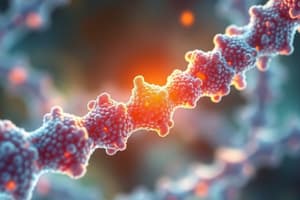Podcast
Questions and Answers
What are ORFs in the context of annotating genomes?
What are ORFs in the context of annotating genomes?
Open Reading Frames
Explain the process of forward genetics.
Explain the process of forward genetics.
Start with phenotype and analyze mutation responsible.
What is the function of transposable elements?
What is the function of transposable elements?
DNA that copies itself and injects itself elsewhere.
How is DNA profiling typically conducted?
How is DNA profiling typically conducted?
What is the focus of 23andMe testing?
What is the focus of 23andMe testing?
Why are BRCA1 and BRCA2 genes important in medical testing?
Why are BRCA1 and BRCA2 genes important in medical testing?
What is the function of the Huntingtin (HTT) protein?
What is the function of the Huntingtin (HTT) protein?
How does Huntington's disease (HD) affect individuals?
How does Huntington's disease (HD) affect individuals?
What is the Founder effect in the context of Huntington's disease?
What is the Founder effect in the context of Huntington's disease?
What are the 4 building blocks of DNA?
What are the 4 building blocks of DNA?
Describe the structure of DNA's double helix.
Describe the structure of DNA's double helix.
What is the Human Genome Project?
What is the Human Genome Project?
How is DNA organized in cells?
How is DNA organized in cells?
What is Huntington's Disease?
What is Huntington's Disease?
Flashcards are hidden until you start studying
Study Notes
DNA Structure and Function
- DNA is composed of 4 building blocks: deoxyribose, sugar, and 4 nitrogenous bases (A, T, G, and C)
- Nitrogenous bases pair together in a specific manner: A-T and G-C
- DNA is linked together with covalent bonds between sugar and phosphate molecules
- The double helix structure has major and minor grooves and is antiparallel (5' to 3' and 3' to 5')
Proteins
- Proteins are composed of amino acids linked together with covalent bonds
- Amino acids have central carbon atoms with different side chains that dictate condensation
- Protein folding involves primary, secondary, tertiary, and quaternary structures
Genomics
- The Human Genome Project was proposed in 1984, started in 1990, and completed in 2003
- The project cost $2.7 billion initially, but now costs only $600
- The human genome consists of approximately 3 billion base pairs, with 99.99% identical to other humans and 99% identical to chimpanzees
Chromosome Organization
- DNA is wrapped around histones to form chromatin, which condenses to form chromosomes
- Humans have 46 chromosomes, with the sex chromosomes being X and Y for males and XX for females
Huntington's Disease
- Huntington's disease affects brain function, including movement, intellect, and emotions
- The disease is caused by an expansion of a CAG repeat on chromosome 4, affecting the Huntingtin (HTT) protein
- Symptoms typically appear between ages 35-45, and death occurs within 10-15 years
Mendel's Postulates
- Mendel's laws of segregation and independent assortment describe how traits are inherited
- The dihybrid cross involves the segregation of two different traits, which can be predicted using Punnett squares
Mutations and Genomics
- Mutations can be classified as gain or loss of function
- Recessive mutations affect individuals with unaffected parents and may skip generations
- Dominant mutations affect structural, control functions, and other unknown aspects
Annotating Genomes
- Open reading frames (ORFs) are identified as potential protein-coding sequences
- Genomes are compared to mRNA sequences to identify functional genes
- Homologous genes are searched for in model species to identify conserved functions
Genomes and Genetics
- Forward genetics involves starting with a phenotype and analyzing the responsible mutation
- Reverse genetics involves inducing mutations and analyzing the resulting phenotype
- Transposable elements are DNA sequences that copy themselves into other locations in the genome
Studying That Suits You
Use AI to generate personalized quizzes and flashcards to suit your learning preferences.




